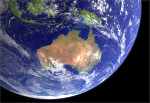|
|

|
| 1925 First 3LO ABC station at Essendon, Victoria |
1950
Following the collapse of the Australian DX Club in 1949,
there was no national hobby organization in Australia dedicated to people interested
in monitoring distant radio stations on shortwave and medium wave for the next two decades
The commercial magazine “Wireless Weekly”, which
started in 1922, later becoming the monthly “Radio and Hobbies” in 1938, published a vast amount of information
about radio in all its forms, including shortwave, medium wave and long wave.
1953
Enthusiasts in Australia could join one or both monitoring
clubs based in New Zealand - the New Zealand DX Radio Association ((NZDXRA - founded in 1933 closed down in 2008) or the New
Zealand Radio DX League ((NZRDXL - still active at the present time).
I had joined both Clubs.
1957
The Victorian Branch of the NZDXRA had its inaugural meeting
in Melbourne on August 29, 1957, and other
Branches were formed in Perth, Hobart, and Sydney.
1963
During 1963 a large and rapid increase in Australian memberships
for both New Zealand clubs had occurred.
At around that time, general purpose communications
receivers were appearing on the Australian market, as were good quality, relatively inexpensive receivers from disposal/war
surplus sources.
The first general purpose receiver to go on sale in Australia in that era was probably the Lafayette
HE30, with its direct and band spread tuning dials, with good sensitivity and selectivity
There was a short-term boom with the “CB Radio”
madness, and the Wireless Institute of Australia's
Youth Radio Scheme encouraged youngsters to move into active radio as hobby.
Radio construction was attracting large and sustained interest
for younger people in the mid-1960s, and the hobby of "DXing" was seen as a logical and natural progression for many youngsters
in their teenage years.
1964 - BRANCHES OF NEW ZEALAND DX CLUBS IN AUSTRALIA
On December 5, 1964, the Sydney Branch of the New ZEALAND
RADIO DX LEAGUE had its first meeting. It had been set up specifically for later conversion into a re-born all-Australian
Club.
In Melbourne, a Branch of the NEW ZEALAND DX RADIO DX ASSOCIATION was operating,
for similar reasons to the Sydney Branch of the League.
The Sydney Branch of the League issued its own bulletin,
the “Australian DX News”, and the Victorian Branch of the NZDXRA published "The Victorian DX Listener".
I moved into the position of Branch Secretary in December
1964.
The Victorian Group met each month on Friday nights at members’
homes. Monitoring weekends to relatively noise-free locations were arranged,
such as to the Mornington
Peninsula.
These became colloquially known as “DX-peditions”, borrowing the term from our amateur radio colleagues!
Day trips were also made to various technical
centres, including the Australian Army’s Receiving and Transmitting facilities at Rockbank and Deer Park, west of Melbourne
(in 1964), and to the Watsonia Military Base, north of Melbourne. We also visited the Lyndhurst Transmitting Station of the
then PMG' Department, south east of Melbourne.
See archival photos below!
The Deer Park and Rockbank stations were closed down in 1969.
Everything was dismantled and some of the towers were transported by low-loader in 2002 to HCJB's new facility at Kunnannurra,
Western Australia.
In late 1964, I started producing taped DXing programs
for local mediumwave stations, titled “The World at Your Fingertips”. See my separate Chapter in this Journey
for the details!
|

|
| 1945 - antennas at Rockbank Army receiving station |
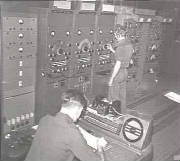
|
| 1945 - Rockbank Army receiving station |
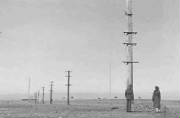
|
| 1943 - Antennas at Diggers Rest Army transmitting station |
|
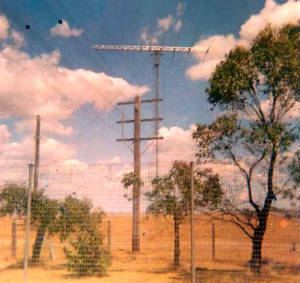
|
| 1971 Antennas at High Park Receiving Station |
1965 - THE AUSTRALIAN RADIO
DX CLUB
On June 19 1965 the Sydney Branch of the NZRDXL was annulled
and the Australian Radio DX Club was set up in its place, and the Australian DX News now became the printed voice of the newly
formed national society.
1966
On April 15 1966, the Victorian Branch of the NZDXRA was
wound up and became the Victorian Branch of the ARDXC, and the inaugural meeting attracted 15 people.
In that year, several trips were undertaken between Melbourne
and Sydney by a small core or members. In July, I travelled to Sydney, to participate in a monitoring
trip to the Blue Mountains with two members from Sydney.
We went to Mt Victoria,
near Katoomba, driving in a blizzard. We stayed in an earthen-floor cabin, and that weekend was one of the coldest ever experienced
in the area! Heating was from an old iron wood stove!
In 1966, I also travelled to Adelaide to meet the members of the South
Australian Branch.
1967 – ARDXC TRANSFERS
TO MELBOURNE
Unfortunately, serious doubts had emerged in late in 1965
as to the long-term viability of the new all-Australian Club.
There were no Rules or Constitution, and the club was administered
by a single individual, a young bank-clerk, with one other person (a teenage student) to assist. The Club was in essence a
hand printed newsletter, produced on a Fordigraph purple-print duplicator. A second-hand ink-type duplicator, using wax stencils
was subsequently acquired.
The Victorian Branch of the ARDXC continued to publish its
own magazine, the Victorian DX Listener, which was often bigger and more timely than the parent Australian DX News, in Sydney.
The December
1966 ARDXC bulletin was the last to be published from Sydney, following the resignation of the people delivering key administrative
functions there.
In a desperation move, a few Melbourne members, headed by myself, following a request from the Sydney people, decided to accept the administrative
responsibility for the Club and in publishing its bulletin on a temporary basis. The
only alternative was to dissolve the club, which by that time had grown to over 100 members.
We created a Management Committee in Melbourne, mainly composed of younger
people
The January 1967 issue of the
Australian DX News was the first to be published from Melbourne,
using the antiquated hand-operated ink-type duplicating machine, and wax stencils, sent down from Sydney..
I was part of the ARDXC administration team continuously,
from inception in June 1965, until I disassociated myself from the organization in 2000.
In early 1967, we introduced a basic Constitution and Rules,
which stood the test of time for the next 30 years!
We also developed the first version of the QSL Competition
Points List and Radio Countries List.
In 1967
I received a special award for “Service to ARDXC, in the form of a beautiful engraved cup, made possible by the
generosity of a Club Patron, Mr Fred Kluth, in country NSW..
1968
By that year, Branches had started to appear outside of Melbourne across Australia,
including a reformed Sydney group, Brisbane,
Hobart, Launceston, Wollongong, Adelaide, Hamilton, Perth, Canberra,
and the Goldcoast. Regrettably, most of these regional groups had lapsed by the mid 1980s.
These Branches were simply groups of members in defined geographical
areas, who met informally from time to time. They had no power or authority in management of the Club’s affairs, but
were consulted for their opinions and suggestions on major issues and proposals. .
1970s – PEAK ACTIVITIES
The peak activity years of the ARDXC were from the early
1970s to the mid-1980s
This was marked by a massive increase in interest, membership
growth, and activity, bolstered by the large number of youngsters, mainly boys, who had taken up DXing, helped by the ready
availability of inexpensive all-band communications receivers, many produced in Japan and others offered via military disposals
stores.
Many of these young people were resident in Melbourne, and gravitated into administrative
positions, enjoying the excitement and vibrancy of involvement in a challenging social activity, and in a Club which had a
peak membership of 680 in November 1983.
We introduced the concept of “Cadet Committeeperson”
where younger members would be given the opportunity of serving as “trainees”, to prepare them for entry to the
Committee itself at a later time.
In those years, many National annual Conventions were held,
some attended by over 100 people, in Melbourne,
Canberra, Mt. Gambier,
and Sydney.
In Melbourne, monthly meetings were held, at members’ homes, some
attended by upwards of 30 people! These meetings were subsequently held at a leased hall in Brighton.
The Melbourne
members arranged a myriad of day trips/barbecues to places of scenic interest, which included the You Yang’s’
Mountains, Eildon Reservoir, Powelltown, Mt Macedon, and the Kinglake National Park.
Weekend and longer monitoring trips, with smaller numbers
of members were made to rural locations, staying in rented houses, holiday cabins, farms, on-site caravans, family holiday
houses, or tents. The locations were selected due to their isolation from sources of heavy power-line interference. Destinations
included Ranceby (Gippsland), Apollo Bay, Yarram (Gippsland), Wallaga Lake (NSW), Tasmania, Lorne, Cowes, Leongatha, Harkaway,
Hamilton, Inverloch, Lakes Entrance, Woods Point, Flinders Island, Flinders Ranges, Wilson’s Promontory, Blairgowrie,
Beaconsfield, the Western District, South Australia, NSW, Queensland, Macrae,
and the Victorian Alps.
Melbourne members also arranged visits to places of technical interest, such as the
PMG’s High Park Receiving Station (near Kilmore) and the Omega submarine very low frequency Navigation
Station (near Yarram).
Editorial support for the magazine was extremely high
in the 1980s, with a remarkable 118 members contributing to the June 1981 issue, 25% of the total membership!
1970s - RIVAL CLUBS
In the 1970s, a plethora of DXing organizations had emerged
across Australia, all claiming to represent
the national interests of monitoring enthusiasts.
Mainly administered from major capitals, the instigators
of these groups had little understanding of the effect on the existing national Club (ARDXC) by setting up these competing
groups.
Membership of some of these organizations was by invitation
only, and was usually driven by single individuals.
Sadly, this absurd multitude of Clubs, all striving for supremacy
and desperate for new members from the same geographical regions, generated hostility and discontent across the radio hobby
community.
Unlike the amateur radio community, there was no regulation
of the “DX” Club movement, or of the application of common standards within these new groups.
In the 1970s, the ARDXC situation became ugly on several
occasions, when members of its management team in Melbourne
were being harassed by people subsequently found to be linked to some of these splinter organizations. This was marked by
anonymous abusive and obscene phone calls at all hours of the day and night, and anonymous postal mailed death threats.
In 1986, the ARDXC became an Incorporated Association (Victoria),
and a new Constitution was adopted. Many other Victorian societies, arts groups, book clubs, sporting clubs, and similar organizations
also secured incorporation.
1971
This was the year in which the first of many national Conventions
took place. Held in Melbourne,
it attracted over 100 participants, and included a trip to the High Park Receiving Station, near Kilmore, and a visit to the
Radio Australia and ABC studios.
Many more national Conventions were held in the ensuing years,
including Sydney (1972), Mt-Melbourne (1973 and 1977), Mt Gambier (1979), Hamilton,
and Canberra
(1978). The Canberra
event included a trip to the Space Tracking Station station at Tidbinbilla. Melbourne was the location of the remaining Conventions, in 1980, 1981,
1982, 1983, 1984, and 1985,
The last national Convention was held in Melbourne in 1985, with about 100 people
attending. This took place at the newly opened studios of Radio Australia,
in suburban East Burwood.
The Conventions were marked by the presentation of Awards,
for members who had been nominated for their dedication, support, and participation in a range of Club activities, or in the
hobby generally.
1972
This was the Sydney Convention at which I was honoured and
surprised to receive the Club’s first Life Membership Award.
.
1978
In that year I was part of the initial editorial team of
the Australian commercial magazine "Amateur Radio Action", looking after the first SWL column, which ran until 1995. This
provided national publicity to ARDXC free of charge and generated many membership requests.
I produced reviews for ARA of many communications receivers
and general articles about radio communications.
Another magazine of the era with a SW column was CB Action,
which ran from October 1977 until July 1995, and we had free advertising in it.
CBA and ARA combined in August 1995 to form a new magazine
titled Radio and Communications, later being renamed to Radio Magazine, until its ultimate demise around 1999.
These magazines were eventually abandoned due to declining
sales, negligible advertising support, as a consequence of the emergence of the internet, mobile telephone technology and
the high cost of physical production and distribution..
ARDXC had relied a great deal for its marketing presence
on its continued advertising in these magazines, to generate a steady movement of membership enquiries, promotion of the hobby,
and new members – the disappearance of these magazines meant that there
was no longer a national commercial printed publication across Australia, .covering shortwave radio communications.
1979
During that year, a monthly shortwave column appeared in
the Melbourne
“Age” newspaper in its “Radio and TV Guide”. The person authoring the column was a capable writer,
but was not a member of any Club, and relied heavily on information provided by me, on behalf of the ARDXC. This column ran
until around 1981 and was a source of many enquiries and new members.
|
|
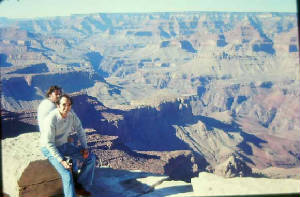
|
| 1975 - Me at Grand Canyon, USA |
1960s and 1970s OVERSEAS
TRIPS
In that era I travelled to many overseas destinations, combining
Radio Club business with recreation!
These excursions included:
1964 New Zealand and Papua New Guinea
(two week cruise and land tour, meeting with radio enthusiasts in Wellington
and Christchurch
1968 Fiji Islands, ten
days, with another ARDXC Melbourne member. We took my Eddystone EC10 communications receiver with us, and met up with one
of our Sydney
members there!
1970 New Hebrides, ten days, with a mate from Melbourne. We visited the New Hebrides
Broadcasting Service studios for an article. Drove roind the main island in a hired Mini Moke!
1975, with fellow ARDXC Committeeman Robert James, to the USA, on a two week trip, where we met with many people in the
radio monitoring community, in San Francisco, Los Angeles, and the East Coast.
1982 Europe, four weeks, with an ARDXC member. We attended meetings of radio enthusiasts
in Germany, Denmark,
and Austria. We spent some days with my
relatives in Livorno,
Italy.
1980s
In the late 1980s, I made several interstate trips to our
Branches to meet up with members there. My Committee companion was Mick Ogrizek, who had taken over the role of Editorial
Coordinator. We attended meetings of ARDXC members in Perth,
Sydney, and Brisbane.
1987
In 1987 a handful of radicals in Melbourne decided to create yet another
new Club, using the ARDXC’s name. Rogue elements in that breakaway outfit organized a public meeting in Melbourne, illegally
promoted as an ARDXC General Meeting using a stolen membership list, where they proceeded to elect people to their committee,
and fraudulently represented themselves as the “Committee” to the Club’s bank, Post Office, and financial
institutions, in an attempt to gain control of the Club’s assets, incoming mail and funds.
This irresponsible behaviour resulted in a large number of
members resigning from the ARDXC.
The issues were resolved by the legitimate ARDXC management
committee calling a special General Meeting in Melbourne,
which resolved to expel the ringleaders of the breakaway group, and access to our funds was restored.
1988
In that year we produced a 110 page publication titled “Mediumwave Guide to Australia and the Pacific.
1989 – FEDERATION
PROPOSALS
A Federation of Australian DX Clubs was proposed by the ARDXC
in the late 1980s, which would have linked all of the Clubs under a single banner, and publishing a common newsletter.
This never materialized.
THE 1990s DECLINE
By the early 1990s, age creep had started to increase, and the Club’s mean membership age had risen to over 50, due to the steady loss
of people who had entered it in their teenage years and who had moved on to other interests.
Very few younger people under 30 years of age were joining
It was becoming increasingly clear that the Club could not
survive indefinitely without the infusion of new, younger, smart, active computer-savvy members, from the Melbourne area.
Membership had peaked in November 1983 at 680, but this had
dropped to 199 by February 1993. It continued to fall steadily to 90 by the end of 1995.
1992
In that year, we developed and published a comprehensive
professionally printed “Members’
Handbook” which included a completely revised section titled “Countries List and Station Counting Guidelines”.
It also contained the Club’s Statement of Purpose and Constitution.
1994 - THE DECLINE CONTINUES
By 1994, the Club had become virtually leaderless, with key
positions on its Management Committee remaining unfilled, and I had stepped into the President’s position as an emergency
measure.
Some Committee members, including me, had given notice they
would not be standing for a further term at the next Annual General Meeting.
1995
At the AGM held in December 1995, the position of Secretary
did not attract any nominations, and no nominations were received from Melbourne for the positions of President or vice-President. Two individuals
located in Sydney
nominated for the offices of President and vice-President, and assumed those roles by default, even though they were
not present at the AGM.
This meant that the incoming Committee was dispersed across
Victoria and NSW, with key office bearers in two States, thousands of km apart. One was located in a Victorian country town.
1996
The magazine continued to be produced and mailed from Melbourne, but in mid-1996 the Melbourne-based Editorial
Coordinator (Principal Editor) stepped down from his position, and this function was transferred to Sydney.
Along with many other long serving members, I had become
totally disenchanted at the direction in which the Club had taken, where the principles of democratic management, equality,
respect, fairness, consideration of divergent views, and the right to be heard were
no longer on the Club’s management agenda.
Membership had fallen to a very low 90, and many members
had expressed serious concerns at management decisions, which include extraordinary appalling attempts inn 1997 and 2000 to
expel two Life Members, and to annual their Life Membership Honours, each of whom had served the Club faithfully in many positions continuously since its inception.30 years previously.
It is noted that many members contacted the Club about its
decision to dismiss two of the Club’s longest serving Life Members. The Committee had refused to indicate in any way
to these two members (one of which was myself) the reasons for its actions.
In 1996, I believed that there was no future for me in attempting
to serve the Club in any form, and I terminated my commitment as the compiler of the ARDXC’s “Shortwave Station
News” (after 30 years at the helm!), and the “Australian DX Press Newsletter”. I continued to manage these
services as independent publications, produced under the banner of the newly formed on-line Electronic DX Press..
I also switched the weekly DX radio programs over international
broadcasters from the ARDXC, and set these up as independent services, which survive until the present day!
I decided the Club’s activities had become totally
incompatible with mine, and I disassociated myself from the organization in 2000, and my radio-monitoring energies were then
directed into management of the Electronic DX Press Radio Monitoring Association.
Since 2000, I have refused to have any contact with people
involved with the management of the ARDXC.
PASSING PARADE
In my 30 years of continuous stewardship to the ARDXC, from 1965 to 1996,
2780 people joined the Club. The average length of stay was one year, and by December 1995, membership had dropped to 90.
The peak membership was 680 in November 1983.
1996
– SOMETHING NEW
In January 1996, two of us (Mick Ogrizek and myself) set
up the Electronic DX Press Radio Monitoring Association.
The EDXP was actually the "E-DXP", but soon became known
as “EDXP”. The EDXP was distributed each week, free, via E-mail, using CompuServe, to various Clubs, organisations
and individuals worldwide who were willing and able to participate.
It was a compiled publication (not cut-and-paste), and recipients
were obliged to contribute news and information to remain on the free mailing list. Organisations, including broadcasters,
were required to make available their own publications, either via postal or E-mail, in exchange.
The EDXP was the descendent of the “Australian DX Press”,
a service of the ARDXC from 1986, compiled by me, the first independent compiled
E-mailed HF monitoring newsletter in Australia,
and by 1998, its distribution exceeded 350!
We chose to position EDXP primarily to support shortwave
broadcasting from, and to, the Asia-Pacific region, as we regarded it as absurd to attempt to cover other geographical regions.
However, we included news and information from outside those areas, where appropriate, as well as Australian medium-wave,
consistent with member interest. The title was actually "The Electronic DX Press Australia", but most people referred to it as, simply, "The EDXP"!
In the early days, the EDXP was also made available as a
printed publication, in parallel with the electronic version. Copies of the printed editions are archived for public viewing
in the National Library, Canberra,
ACT.
EDXP survives to the present time!
|
OTHER CLUBS OF WHICH I HAD
BEEN A MEMBER
I have continued to maintain my membership with the North
American Shortwave Association, which I joined in 1965, and the Danish SW Club International, since 1970.
I left the NZRDXL and
NZDXRA in 1970.
There were several other monitoring Clubs of which I had
been a member for varying durations, including the West Indian DX Association, the Union of Asian DXers, the Benelux DX Club,
the International SW League, the British DX Club, the Newark News Radio Club, the American SW Listeners’ Club, the National
Radio Club, the South African DX Club, and the International Radio Club of America. Some of these survive to the present day,
but those that still exist are irrelevant to my interests.
INTERNATIONAL TRIPS
Beginning in the 1990s, I attended several international
Conferences of the European DX Council; initially representing the ARDXC in 1998 and 2000, and in 2002 where I was an advocate
for the Electronic DX Press.
These meetings were held in Gothenburg (Sweden - 1998),
Barcelona (Spain
- 2000), and Pori (Finland – 2002) and my attendance was at my own expense. They attracted hundreds
of participants, not only from Europe but from further afield, including the USA.
Attendance was from hobbyists, amateur radio enthusiasts,
broadcasters, publishers, hobby clubs, and media representatives.
The 2002 Meeting was hosted by the Finnish DXing Federation,
in a rural spa resort north of Helsinki.
I was awarded a nice engraved trophy for the Most Distant Visitor!
WRITING FOR OVERSEAS MAGAZINES
For some years, in the 1990s, I was a guest writer for the
Amercian magazines “Monitoring Times” and “Popular Electronics”.
I authored several articles on various radio themes, incluiding accounts of my trips to Tonga,
Samoa, and Spain.
|
|
 |
|
|
 |
|
|
 |
|
|
|
